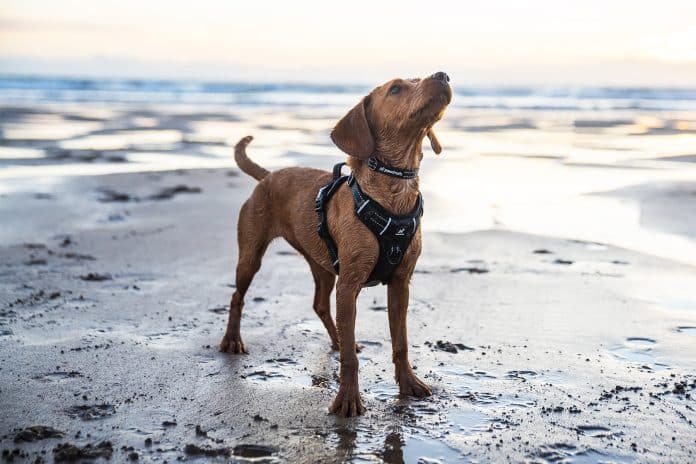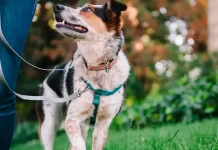Is your pup ready to take the leash and explore? Or perhaps you want to ensure they wear a harness for extra safety during walks.
Either way, fitting a dog harness can be tricky if you don’t know how. This article will provide an easy step-by-step guide on how to fit a dog harness properly.
From measuring your furry friend to fitting the harness snugly, these tips will ensure that your pup is comfy and safe for any adventure!
What is a dog harness?
A dog harness is a device that helps distribute a dog’s pulling force evenly across its chest and shoulders, rather than just putting all the pressure on its neck.
It is especially useful for dogs who pull on the leash, as it can help to prevent them from choking or injuring themselves.
Many types of dog harnesses are available, so choosing one that is comfortable for your dog and fits them properly is important.
Why do you need a dog harness?
There are a few reasons why you might need a dog harness. Maybe your dogpulls on the leash and you want more control.
Or, perhaps you have an older dog or a puppy who isn’t ready for a traditional collar and leash.
A harness can also be a good option for small dogs who a collar and leash could easily injure. Whatever your reason, it’s important to make sure you choose the right size and style of harness for your dog.
How to choose the right size dog harness?
When choosing the right size dog harness for your pup, there are a few things to consider. Their weight and girth are the two main measurements you need to consider.
The weight of your dog will determine what size of harness is best. For example, a tiny Chihuahua will need a small harness, while a large Great Dane will require an XL size.
Most harnesses are sized by small, medium, large, and extra-large.
Girth is the measurement around your dog’s chest, just behind its front legs. This is critical in ensuring the harness fits snugly but doesn’t constrict their breathing.
A good rule of thumb is to add 2-3 inches to their girth measurement to find the right size harness.
If you’re still unsure what size to choose, err on caution and go up a size. It’s always better to have a little wiggle room than to be too tight.
And finally, always double check the manufacturer’s sizing chart before making your purchase!
How to put on a dog harness?
There are a few things to remember when putting on a dog harness. The first is to ensure the harness is the right size for your dog.
The second is to put the harness on correctly, so it is comfortable for your dog and does not rub anywhere.
To put on a dog harness, start by holding the harness open so that your dog can step into it. Then, put each of your dog’s front legs through the appropriate holes in the harness.
Finally, clip the buckles together and adjust the straps as needed so that the harness fits snugly but not too tight.
Tips for using a dog harness
You may consider using a harness instead of a leash and collar if you have a dog. A harness can provide extra security and comfort for your dog and can be especially helpful if your dog is pulling on the leash or has issues with his neck.
Here are some tips for using a dog harness:
- Choose the right size harness for your dog. The harness should fit snugly around your dog’s chest and shoulders, and should not be too loose or tight. You may need to adjust the straps to get a perfect fit.
- Put the harness on your dog before attaching the leash. This will help avoid confusion or tangling when trying to put it on him.
- Make sure the leash is attached securely to the harness. You don’t want it to come undone while you’re walking or playing with your dog.
- Start slowly when using the harness for the first time. Let your dog get used to it by walking around the house or yard before heading out on a long walk or hike.
- Be consistent with using the harness. If you only use it sometimes, your dog may become confused and resist wearing it. Use it every time you take him for a walk or run, and he’ll soon get used to it
How should my dog’s harness fit?
A dog harness should fit snugly and comfortably around your dog’s chest and shoulders.
There should be enough room to slip two fingers between the harness and your dog’s body, but it should not be so loose that it slides around on your dog’s body.
The straps of the harness should be adjustable so that you can find the perfect fit for your dog.
Should dog harness be tight or loose?
Harnesses are a great way to keep our dogs safe and secure, but it’s important to ensure they fit properly.
A harness that is too loose can be easily slipped off by a determined dog, while one that is too tight can be uncomfortable and restrictive. Luckily, there is a happy medium!
The ideal fit for a dog harness is snug but not tight. You should be able to slip two fingers under the straps at the widest part of your dog’s chest, with just a little room to spare.
The straps should also not impede your dog’s movement or prevent them from comfortably enjoying their walks.
If you’re unsure whether your dog’s harness fits correctly, ask a professional at your local pet store for help.
They will be able to assess your dog’s size and shape and recommend the best size and style of harness for them.
Does it hurt a dog to pull on a harness?
No, it does not hurt dogs to pull on harnesses. Many dogs find it quite comfortable to wear a harness while walking or running.
However, if your dog is constantly pulling on the harness, it may be time to invest in a better-fitting option or seek additional training.
Why do dogs not pull when wearing a harness?
While it may seem that dogs would naturally pull when wearing a harness, there are a few reasons they may not.
First, harnesses distribute the dog’s weight more evenly than a collar does. The dog is less likely to feel uncomfortable or strained while wearing a harness.
Additionally, harnesses provide more control over the dog’s movement than a collar does, which can help to prevent them from pulling on the leash.
Finally, many dogs do not like the sensation of having their movement restricted, and will therefore avoid pulling on the leash when wearing a harness.
How do I know what size harness my dog wears?
You can determine what size harness your dog wears in several ways. The first way is to measure your dog’s chest circumference.
Wrap a measuring tape around the widest part of your dog’s chest, just behind the front legs. Once you have their chest measurement, consult a size chart to find the corresponding harness size.
Another way to determine what size harness your dog needs is by measuring its weight. Again, consult a size chart to find the right harness size for your pup based on weight.
And finally, you can always take your dog to a pet store and try on different harnesses until you find one that fits them well.
How do I know if my harness is too small?
If your dog is constantly trying to wriggle out of their harness, it is likely too small.
Other signs that your dog’s harness is too small include chafing around the neck and chest, and difficulty getting the harness on and off.
If you’re unsure whether your dog’s harness is too small, consult a professional or take your dog to a pet store for a fitting.
Conclusion
Fitting a dog harness is important in keeping your pup safe and secure when out and about.
The tips in this article will help you figure out the proper harness size for your four-legged family member and how to fit it for maximum comfort properly.
Learning how to fit a harness correctly can be challenging, but with practice and patience, you’ll be able to keep your furry friend safe without sacrificing comfort or style.









































